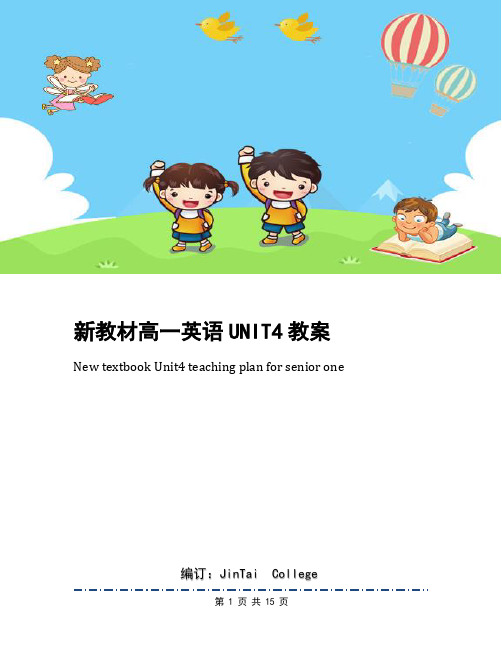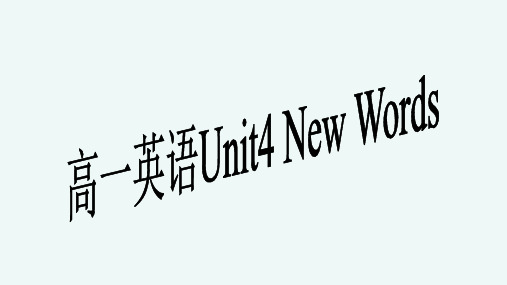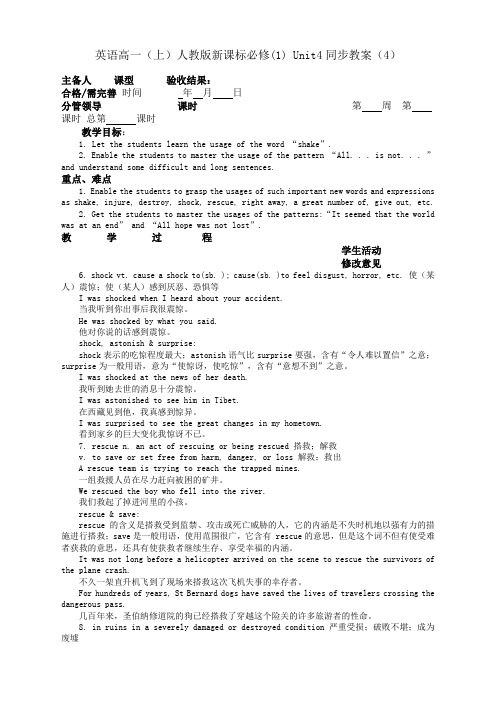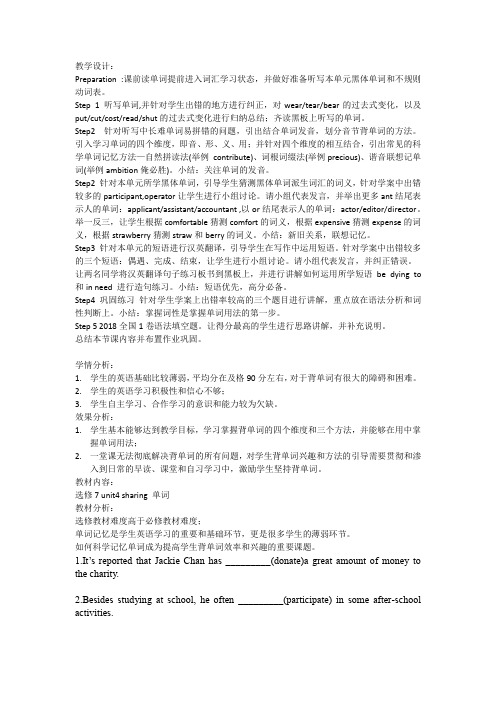高一英语教案:上学期unit4 new words
- 格式:doc
- 大小:23.00 KB
- 文档页数:3

高中高一英语教案:新教材Unit4
教学目标
•熟练掌握本单元的基本语法,包括现在完成时、一般过去时等;
•能够运用所学知识描述人物、状况等;
•培养学生的听说读写能力。
教学重点
•掌握现在完成时和一般过去时的用法;
•学会描述人物和状况;
•培养听说读写能力。
教学难点
•熟练运用过去完成时的用法;
•能够准确地描述人物和状况。
教学方法
•自主学习法;
•合作学习法;
•小组讨论法;
•任务型教学法。
教学过程
Step 1 自主学习
学生在课前自主预习本单元的课文和相关语法知识,提出疑点和疑问,并做好笔记。
Step 2 合作学习
学生以小组为单位,互相交流自己的学习笔记和问答内容,一起讨论并解决问题。
老师在此过程中及时纠正和指导。
Step 3 小组讨论
老师提供一个话题,让学生以小组为单位进行讨论,要求每个组员都积极参与,并阐述自己的观点和理由。
Step 4 任务型教学
老师根据学生的实际水平和兴趣爱好,设计一些任务型教学的活动,比如说配对练习、听力测试等。
总结
本单元的教学重点在于掌握现在完成时和一般过去时的用法,学会描述人物和状况,以及培养听说读写的能力。
在教学过程中,要求学生自主学习、合作学习、小组讨论和任务型教学,尝试让学生更加活跃地参与到语言学习中,并根据学生的实际情况进行个性化的教学。

新教材高一英语UNIT4教案New textbook Unit4 teaching plan for senior one编订:JinTai College新教材高一英语UNIT4教案前言:英语作为在许多国际组织或者会议上都是必需语言,几乎所有学校选择英语作为其主要或唯一的外语必修课。
英语教学涉及多种专业理论知识,包括语言学、第二语言习得、词汇学、句法学、文体学、语料库理论、认知心理学等内容。
本教案根据英语课程标准的要求和教学对象的特点,将教学诸要素有序安排,确定合适的教学方案的设想和计划、并以启迪发展学生智力为根本目的。
便于学习和使用,本文档下载后内容可按需编辑修改及打印。
A: aims1.Talk about past experiences,2.Describe pe ople, things, events and people’s feelings,3.Review the attributive clause and learn to use relative pronouns who, whom, whose, which and that,anise ideas in a text using First, Next, Then, Finally, and5.Write about an unforgettable experience.B: Difficult points and baffling questions1.The uses of the relative pronoun: who, whom, whose, which and that,2.Some language points in the unit,3.How to organize ideas by using First, Next, Then and Finally, and4.Writing speedC: Steps (6 periods)Ⅰ.The first period1.Warming upT: We have four pictures and some clues here. Do you know them? Now talk about the four pictures, using the attributive clause.When we talk about people we use who, whom or whose in the attributive clause, while which /that refers to things in the attributive clauseS:T: Why are these persons or things/events unforgettable?S:T: Who’d like to introduce some other persons or events or inventions?S:2.ListeningT: We’re going to listen to a man who survived the 1989 earthquake in San Francisco, U.S.A. Now read through the exercises, listen to the tape (twice) , just grasp the points to the questions, and complete the exercises.After that, check the answers by the students telling their answers and then listen a third time.T: Now let’s come to the listening on Page103.We’re going to listen to a dialogue. There’re some people talking about four people at a party. What are they talking about? Their names, their jobs, theirplaces, their age and their looks. So you should just grasp the description. Also we play the tape twice. In order to check your answers, we’re going to play a third time.3.Homework1.Write about an unforgettable thing/event within 50 words, using attributive clauses.2.Practice the 4 pictures on Page 22.Ⅱ. The second periodSpeaking. We have two kinds of speaking exercise here.1.Speaking on page 23We have a sample dialogue and three picturesunder it. So we can work in pairs/ groups, to look at the pictures and to create a new dialogue for each picture. In the dialogue you must express your worries, fears and difficulties, using the useful expressionsin the box on page 24.After that, some pairs/groups will act their dialogue out2.Talking on page 103This is a role play. There’re two persons. One plays the person who discovered the important old tomb, the other plays a scientist from Beijing.On page 104, we have some useful expressions to help you make up the dialogue. You’re asked to use “First, Next, Then and Finally”.After the students are ready with their dialogue, some pairs/groups will act out their dialogue.3.Homework1.Practice the dialogue according to the pictures on page 23.2.Disaster pictures collected for a show.Ⅲ. The third and the fourth periodsReading passage 11.Pre-readingT: What kind of natural disasters do you know about?S:T: Have you had/experienced one of them?S:T: Describe what it was like and how you felt, using First…, Next…, Then…, and Finally. You can imagine it if you have never met with one.S:2.ReadingT: Now let’s come to the reading passage. Read in a low voice while listening to the tape.Now tell me what the text is about.S: (about flood and the fact that people in danger were rescued)T: How did the character feel?S: (Amazement and wonder→alarm→fear→panic)Para1 Para1-Para 2 Para 3 Para 5T: Will you have a try and find out some sentences that have metaphorical words in them?S: (see pages 24-25, 6 places or so)3.Post-readingT: Now let’s c ome to some exercises about the reading material. Exercises on page 25.S:T: Now try to tell the story in your own words in brief, using First…, Next…, Then…,and Finally…4.Homework1.Tell the story in your own words, by using First…, Next…, Then…, and Finally…,2.Ex.1 Vocabulary on page 104.Reading passage 25.Check their homeworkOne student tells the story and then some of the students read the sentences in Ex.1, Vocabulary on page 104.6.Now let’s come to the text. I’m going to explain to you some difficult sentences (see pages 24-25), some useful phrases and words.①hearI heard them singing that song in English.The boy saw his classmates playing football.Try to find some more verbs that can take an v-ing.②drag: pull sth./ sb. along the ground because they are too heavy to carryLittle Jerry dragged the table/her father/into the kitchen.Pull: use your hand to make sth move towards you or in the direction that you’re movingv. Help me move the piano; you push and I’ll pull.He pulled his brother out of bed.n. the pull of the moon③seize: take hold of sth. suddenly and violentlyHe seized my hand and dragged me awayseize power/an opportunity/ a chance of v-ingto-v④strike struck, struckA ball struck me (on the back of the head).She struck a match.The clock began to strike 12.The workers are striking for…The disease struck (the city).⑤destroy destroyed, destroyed, destroyingdamage sth. so badly that it can’t be repairedor so that it no longer existsThe school was completely destroyed by fire.⑥struggle: try extremely hard to achieve sth. even though it is very difficult and you have a lot of problemsThe child struggled in the water.He struggled along the road home.⑦There’s some useful phrases in t he text. Just learn then by heart.fight for/against/with…hold onto sb./sth.get on one’s feetlook out of…/into…/at…/roundsweep awaybe upon sb./sth.fall/go /swallow/ sweep sb./sth downpull sb./sth. upmove/run upmove up and down…⑧5 v-ing forms as adverbials (see pages 24-25)7.HomeworkEx in Word study on page 26 and translation on pages 104-105.Ⅳ. The fifth periodGrammar: The Attributive Clause (1)1.IntroductionT: A sentence with an attributive clause is a combination of two shorter sentences. In anattributive clause, we must use conjunctions : Relative pronouns who / whom / whose / that. Read the sentences in the box on page 26 and tell the two apart.In what situation, these conjunctions are used?2.PracticeT: Now 5 minutes for the students to do Ex1-2 on pages 26-27.And then Ex 1 on page 105 in class.Then the students tell the answers one by one. During the teaching, we are going to lay stress on the structure and the uses of the relative pronouns.Now make some other sentences with attributive clauses.3.HomeworkEx. 2 on page 105V. The sixth periodIntegrating skills1.Reading passage on page 27First the students circle the relative pronouns “who, whose, which and that”, and the linking words “and, but” while reading the passage.Next they write sentences about theirunforgettable experience by answering the questions on page 28.Then they should try to use attributive clauses and linking words “and, but”.Finally some of the students read out their passages and their classmates will make comments on their passages.2.Reading passage on page 106After reading, the students should understand the text, correctly, complete the exercises after the text, have a clear knowledge of the damage of an earthquake and gain the ability to write a short passage about an earthquake by using some relative pronouns ,linking words: First, Next, Then and Finally. Also there’re some questions on page 108 for the students to refer to.3.AssessingThe students do it by themselves after class.4.Homework1.Writing on page 108.2.Read the new words in Unit 3-------- Designed By JinTai College ---------。


英语高一(上)人教版新课标必修(1) Unit4同步教案(4)主备人课型验收结果:合格/需完善时间年月日分管领导课时第周第课时总第课时教学目标:1. Let the students learn the usage of the word “shake”.2. Enable the students to master the usage of the pattern “All. . . is not. . . ” and understand some difficult and long sentences.重点、难点1. Enable the students to grasp the usages of such important new words and expressions as shake, injure, destroy, shock, rescue, right away, a great number of, give out, etc.2. Get the students to mas ter the usages of the patterns:“It seemed that the world was at an end” and “All hope was not lost”.教学过程学生活动修改意见6. shock vt. cause a shock to(sb. ); cause(sb. )to feel disgust, horror, etc. 使(某人)震惊;使(某人)感到厌恶、恐惧等I was shocked when I heard about your accident.当我听到你出事后我很震惊。
He was shocked by what you said.他对你说的话感到震惊。
shock, astonish & surprise:shock表示的吃惊程度最大;astonish语气比surprise要强,含有“令人难以置信”之意;surprise为一般用语,意为“使惊讶,使吃惊”,含有“意想不到”之意。

教学设计:Preparation :课前读单词提前进入词汇学习状态,并做好准备听写本单元黑体单词和不规则动词表。
Step 1 听写单词,并针对学生出错的地方进行纠正,对wear/tear/bear的过去式变化,以及put/cut/cost/read/shut的过去式变化进行归纳总结;齐读黑板上听写的单词。
Step2 针对听写中长难单词易拼错的问题,引出结合单词发音,划分音节背单词的方法。
引入学习单词的四个维度,即音、形、义、用;并针对四个维度的相互结合,引出常见的科学单词记忆方法—自然拼读法(举例contribute)、词根词缀法(举例precious)、谐音联想记单词(举例ambition俺必胜)。
小结:关注单词的发音。
Step2 针对本单元所学黑体单词,引导学生猜测黑体单词派生词汇的词义,针对学案中出错较多的participant,operator让学生进行小组讨论。
请小组代表发言,并举出更多ant结尾表示人的单词:applicant/assistant/accountant ,以or结尾表示人的单词:actor/editor/director。
举一反三,让学生根据comfortable猜测comfort的词义,根据expensive猜测expense的词义,根据strawberry猜测straw和berry的词义。
小结:新旧关系,联想记忆。
Step3 针对本单元的短语进行汉英翻译,引导学生在写作中运用短语。
针对学案中出错较多的三个短语:偶遇、完成、结束,让学生进行小组讨论。
请小组代表发言,并纠正错误。
让两名同学将汉英翻译句子练习板书到黑板上,并进行讲解如何运用所学短语be dying to 和in need 进行造句练习。
小结:短语优先,高分必备。
Step4 巩固练习针对学生学案上出错率较高的三个题目进行讲解,重点放在语法分析和词性判断上。
小结:掌握词性是掌握单词用法的第一步。
Step 5 2018全国1卷语法填空题。

统编版高一英语上第四单元教学设计教学目标1. 通过本单元的研究,使学生能够掌握与渴望及采取行动相关的词汇和表达方式;2. 培养学生的阅读理解和写作能力;3. 培养学生的合作和交流能力;4. 培养学生的自主研究和解决问题的能力。
教学重点1. 渴望和采取行动的词汇和表达方式;2. 阅读理解和写作能力的提升;3. 合作和交流能力的培养。
教学内容词汇与表达教授与探讨与渴望和采取行动相关的词汇和表达方式,如"desire," "long for," "dream of," "take action," 等。
阅读理解通过让学生阅读相关材料,提高他们的阅读理解能力。
教师可以选择一篇关于实现梦想的文章,让学生阅读并回答相关问题。
写作能力引导学生在课堂上进行写作练,让他们根据自己的理想和梦想,写一篇短文。
教师可以提供一些写作指导,例如如何组织文章和使用适当的词汇和句型。
合作和交流组织学生进行小组活动,让他们在小组内讨论和分享自己的梦想,并向组员展示他们的写作成果。
这样可以培养学生的合作和交流能力,同时提供一个展示和表达的机会。
教学方法1. 教师讲授与渴望和采取行动相关的词汇和表达方式,并进行示范和练;2. 学生进行阅读理解练,教师可以提供阅读材料和相关问题,并引导学生进行讨论和思考;3. 学生进行写作练,在小组内互相交流和修改;4. 学生进行小组活动,讨论和分享自己的梦想,并展示写作成果。
教学评估1. 针对词汇与表达的练,教师可以进行口头或书面测试,以评估学生的掌握程度;2. 针对阅读理解和写作能力的练,教师可以根据学生的回答和写作成果进行评估;3. 针对合作和交流能力,教师可以观察学生在小组活动中的表现,并进行评估。
教学资源1. 相关课本和教材;2. 阅读材料:关于实现梦想的文章;3. 小组活动材料。
总结本单元的教学设计旨在培养学生的渴望和采取行动的能力,提高他们的阅读理解和写作能力,并培养他们的合作和交流能力。
高一英语unit4教案教案标题:高一英语 Unit 4 教案教案目标:1. 通过本单元的学习,学生将能够掌握并运用有关旅行和交通方式的词汇和表达方式。
2. 培养学生的听说读写能力,提高他们的英语综合运用能力。
3. 培养学生的合作意识和团队合作能力。
教学重点:1. 掌握本单元的重点词汇和短语。
2. 学会运用正确的语法结构和表达方式。
3. 提高听说读写能力。
教学难点:1. 学生对于交通方式的灵活运用。
2. 学生对于旅行经验的描述和表达。
教学准备:1. 教材《高中英语必修一》Unit 4 阅读材料和练习题。
2. 多媒体设备和投影仪。
3. 单词卡片和图片。
教学过程:Step 1: 导入新课 (5分钟)1. 利用图片或视频引入旅行和交通方式的话题,激发学生的学习兴趣。
2. 引导学生讨论并分享自己的旅行经验,鼓励他们用英语进行简单的描述。
Step 2: 词汇和短语学习 (15分钟)1. 呈现本单元的重点词汇和短语,如transportation, destination, accommodation, sightseeing, etc.2. 通过图片和例句的展示,帮助学生理解并记忆这些词汇和短语。
3. 组织学生进行词汇和短语的操练,如单词拼写、词义选择等。
Step 3: 阅读理解与语法学习 (25分钟)1. 学生阅读 Unit 4 的阅读材料,并回答相关问题。
2. 教师引导学生分析阅读材料中的语法结构和表达方式,如定语从句、比较级和最高级等。
3. 教师讲解相关语法知识,并通过例句进行讲解和练习。
Step 4: 听说练习 (20分钟)1. 播放与本单元相关的听力材料,要求学生听后回答问题。
2. 学生分组进行口语练习,模拟旅行经验的对话和描述。
教师可以提供一些问题和提示,引导学生展开对话。
Step 5: 作业布置 (5分钟)1. 布置相关的作业,如完成练习题、写一篇关于自己旅行经验的短文等。
2. 引导学生预习下一课时的内容,做好相关准备。
高中英语新教材UNIT4教学设计高一新教材Unit 4说课,高一新教材Unit 4说课教案,教学设计一.教学目标理论依据:《新课程标准》(实验稿)根据《新课程标准》(实验稿)关于总目标的定位及其实现途径和目标具体描述,结合高一学生实际和教材内容,我们把本单元的教学目标定为:1)语言知识:单词:理解、内化、运用以下生词:seismograph; iceberg; King Tut; // roar; fright; crack; // bookworm; couch potato; workaholic;// Buddha; agent等,扫除听读障碍,重点掌握一些传神动词:advance; seize; sweep; swallow; drag; pull; flow; shake; strike; struggle等。
词组:get on one’s feet; tree after tree语法:复习和运用定语从句用于描述人、物及事件。
2)语言技能:听:听懂一个关于不幸经历的小故事,抓住时间、地点、人物、发生的事件说:能用得体语言描述人、物、事件,并且有一定的逻辑。
读:Scanning, skimming, careful reading, generalization; inference等阅读微技能训练。
写:能运用First, Next, Then, Finally简要且富有逻辑地描写自己的一次难忘经历。
3)学习策略:学生一定程度形成自主学习,有效交际、信息处理、英语思维能力。
4)情感态度:学生能在多种英语学习情景中分享自己的幸与不幸,体验用英语交流的成功与喜悦,以及培养合作精神、互助精神。
二.教学重点和难点:重点:1. 课文中出现的重要动词,如:advance, seize, sweep, swallow, strike, struggle, drag, flow, shake, 及词组get on one’s feet, pull oneself, tree after tree etc.2. 用关系代词who, that, whom, whose等引导的定语从句 .3. 用副词 first, next, then, finally 来描述一场难忘的经历.难点: 能用得体的英语表达自己,描述过去的难忘经历。
词汇(Vocabulary)sweltering ( adj.) :that swelters or suffers from the heat;very hot;sultry热得发昏的;酷热counsel ( n.) :a lawyer or group of lawyers giving advice about legal matters and representing clients in court 辩护律师;法律顾问;辩护人silver-tongued ( adj.) :eloquent;persuasive雄辩的;口才流利的orator ( n.) /'ɔrətɚ/ :a skilled,eloquent public speaker 雄辩家jury ( n.) :a group of people sworn to hear the evidence and inquire into the facts in a law case,and to give decision in accordance with their findings陪审团erupt ( v.) :burst forth or out,as from some restraint 进发;爆发;喷出clash ( n.) :a sharp disagreement;conflict抵触;冲突;意见不一致;对立fundamentalism ( n.) :religious beliefs based on a literal interpretation of everything in the Bible and regarded as fundamental to Christian faith and morals原教旨主义(相信《圣经》所记载的传统的基督教信仰,反对较为近代的教义)legislature ( n.) /'lɛdʒɪsletʃɚ/ :a body of persons given the responsibility and power to make laws for a country or state(esp. the lawmaking body of a state,corresponding to the U.S.Congress)立法机构(尤指美国的州议会) prohibit ( v.) :refuse to permit;forbid by law or by an order禁止;不准legality ( n.) : /lɪˈɡælɪtɪ/ N-UNCOUNT If you talk about the legality of an action or situation, you are talking about whether it is legal or not. 合法性•The auditor has questioned the legality of the contracts.审计员已经质疑合同的合法性indict ( v.) : /ɪnˈdaɪt/ ( especiallyNAmE )[ usually passive ][ VN ] ( law 律) ~ sb (for sth)~ sb (on charges/on a charge of sth) to officially charge sb with a crime 控告;起诉syn. Accuse/charge •The senator was indicted for murder. 那位参议员被控犯谋杀罪。
Teaching plan for unit 4Period 1 Warming upTeaching aims: 1) Talk about “Earthquake”2) Develop students’ speaking abilities3) Learn to protect nature.Key points:Lead the students to talk about earthquake and naturalo diasasters.New words: earthquake; shake; right away; well; rise; crack;pond; pipe; burst; injure; ruin; dirt; destroy; lie in ruins. Teaching aids: 1) computer 2) tape-recorder 3) projector 4) blackboard Teaching methods: Task-based Approach; Student-centered Approach Teaching steps:Step 1. GreetingGreet the students as usual.Step 2. Daily reportStep 3. Lead-in.1)Talk about the earthquake in Taiwan recently.Show the vedio about the Taiwan earthquake.2)Talk about the greatest earquakes in the world.Step 4. Warming-up1)Studnets talk about the pictures in warming up.2)Students imagine the happening after an earthquake.3)Show the students the pictures of the earthquake , and helpthe students to describe the pictures.Step 5. listening ( work-book)“Why do earthquakes happen?”new words: Pacific Plate; North American Plate; Indian plate; movement1)Listen to the tape for the first time and answer the T or Fquestion.2)Listen to the tape again , then try to fill in the chart.3)Students talk bout what they’ve learned about theearthquake.Step 5. HomeworkPrepare”Reading1) Look up the new words. 2)Answer the questions in“Comprehending”。
1.
Unit 4 Unforgettable Experiences
New words:
1.unforgettable adj.forget—forgettable---unforgettable
2.host vt.主办或主持某项活动n.主人,主持人
3.take place
take place &happen
The election of every four years will take place next week.
If anything should happen to the computer, please let us know.
4.scare vt. 恐吓vi.受惊吓
scared adj.恐惧的
be scared of=be afraid of 担心某事发生
be scared to do sth=be afraid to do sth 因害怕而不敢做某事
I’m afraid to dive into the swimming pool.
I’m afraid of falling into the swimming pool.
5.on fire
on fire & catch fire
Paper catches fire easily.
The house is on fire.
6. finally adv. 最后,终于
= at last = in the end
finally 既可以表示时间位置,也可以表示时间顺序。
(first, second, third, finally) Finally, I’d like to thank you all for coming and wish you a safe journey.
at last 只表示时间位置,而且在语意上指经过周折、期待、耽搁等。
His wish to be a university student has come true at last.
in the end 与at last 基本一样,但它可以用于将来时态中,而at last, finally则一般不可。
I hope everything will be all right in the end.
7.advance vi.&vt.前进,提高;n.前进,提升
They advanced to meet the guest.
China is advancing rapidly in industry.
Science has made great advances in the last fifty years.
advanced adj.先进的,高级的
advanced technology
in advance 提前
We finished the project in advance.
8.struggle vi.&n.努力,挣扎,奋斗
struggle against 与…斗争;为反对…而斗争
struggle with 与…斗争;和…一起战斗
struggle for 为争取…而斗争
9.fight vi. 搏斗;斗争;争吵
fight against 与…作战;为反对…而斗争
fight with 与…并肩作战
fight for 为了…而战
10.shake vi.&vt.(shook, shaken)摇动,振动,动摇shake hands with sb. 与某人握手
11. strike v.t&vi.(struck, stricken) 击打,打中
He struck the nail with a hammer.
The ship struck an iceberg. 撞,触
strike a match 划火柴
How does the plan strike you? 给人某种印象或感觉The clock is striking twelve. 钟敲响
12.go through 通过,经受,仔细检查
Go through the center hall.
Many families went through a lot in the war.
Mother went through the drawer for her glasses. 13.destroy vt.摧毁,毁坏
destroy & damage
destroy 至完全破坏,不能修复
damage 只可修复的
14.on holiday
on 在…过程中on business
15.Buddha n. 佛,佛像
Buddhism 佛教
Christianity 基督教
Islam 伊斯兰教。